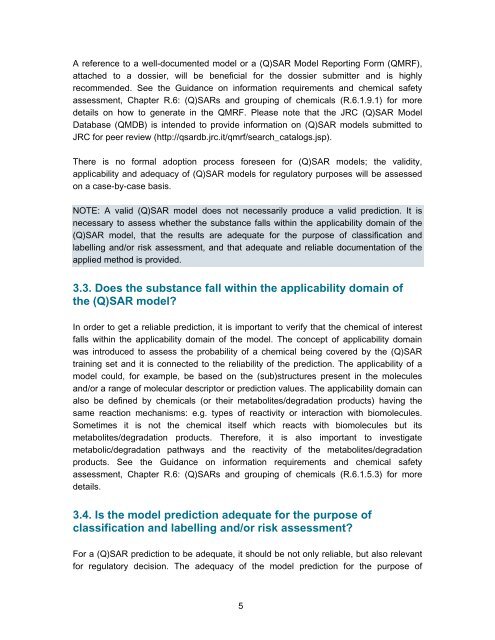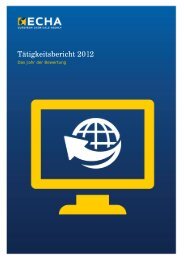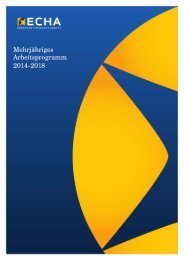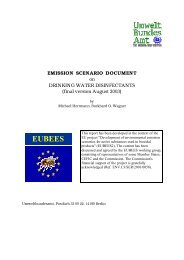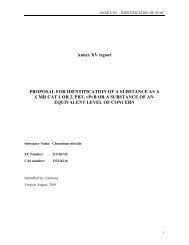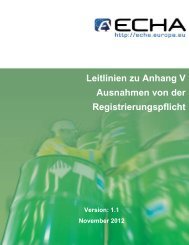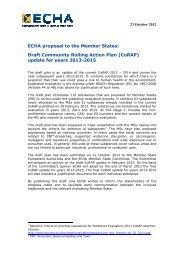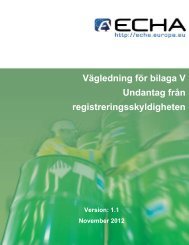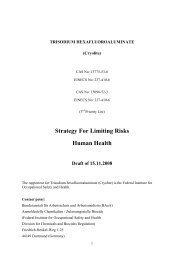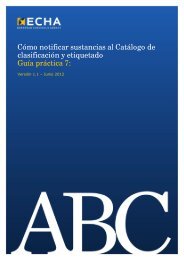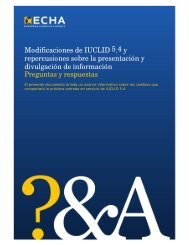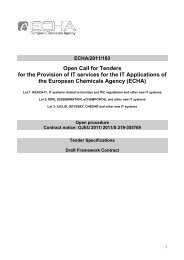Practical Guide 5: How to report (Q)SARs - ECHA - Europa
Practical Guide 5: How to report (Q)SARs - ECHA - Europa
Practical Guide 5: How to report (Q)SARs - ECHA - Europa
Create successful ePaper yourself
Turn your PDF publications into a flip-book with our unique Google optimized e-Paper software.
A reference <strong>to</strong> a well-documented model or a (Q)SAR Model Reporting Form (QMRF),<br />
attached <strong>to</strong> a dossier, will be beneficial for the dossier submitter and is highly<br />
recommended. See the Guidance on information requirements and chemical safety<br />
assessment, Chapter R.6: (Q)<strong>SARs</strong> and grouping of chemicals (R.6.1.9.1) for more<br />
details on how <strong>to</strong> generate in the QMRF. Please note that the JRC (Q)SAR Model<br />
Database (QMDB) is intended <strong>to</strong> provide information on (Q)SAR models submitted <strong>to</strong><br />
JRC for peer review (http://qsardb.jrc.it/qmrf/search_catalogs.jsp).<br />
There is no formal adoption process foreseen for (Q)SAR models; the validity,<br />
applicability and adequacy of (Q)SAR models for regula<strong>to</strong>ry purposes will be assessed<br />
on a case-by-case basis.<br />
NOTE: A valid (Q)SAR model does not necessarily produce a valid prediction. It is<br />
necessary <strong>to</strong> assess whether the substance falls within the applicability domain of the<br />
(Q)SAR model, that the results are adequate for the purpose of classification and<br />
labelling and/or risk assessment, and that adequate and reliable documentation of the<br />
applied method is provided.<br />
3.3. Does the substance fall within the applicability domain of<br />
the (Q)SAR model?<br />
In order <strong>to</strong> get a reliable prediction, it is important <strong>to</strong> verify that the chemical of interest<br />
falls within the applicability domain of the model. The concept of applicability domain<br />
was introduced <strong>to</strong> assess the probability of a chemical being covered by the (Q)SAR<br />
training set and it is connected <strong>to</strong> the reliability of the prediction. The applicability of a<br />
model could, for example, be based on the (sub)structures present in the molecules<br />
and/or a range of molecular descrip<strong>to</strong>r or prediction values. The applicability domain can<br />
also be defined by chemicals (or their metabolites/degradation products) having the<br />
same reaction mechanisms: e.g. types of reactivity or interaction with biomolecules.<br />
Sometimes it is not the chemical itself which reacts with biomolecules but its<br />
metabolites/degradation products. Therefore, it is also important <strong>to</strong> investigate<br />
metabolic/degradation pathways and the reactivity of the metabolites/degradation<br />
products. See the Guidance on information requirements and chemical safety<br />
assessment, Chapter R.6: (Q)<strong>SARs</strong> and grouping of chemicals (R.6.1.5.3) for more<br />
details.<br />
3.4. Is the model prediction adequate for the purpose of<br />
classification and labelling and/or risk assessment?<br />
For a (Q)SAR prediction <strong>to</strong> be adequate, it should be not only reliable, but also relevant<br />
for regula<strong>to</strong>ry decision. The adequacy of the model prediction for the purpose of<br />
5


